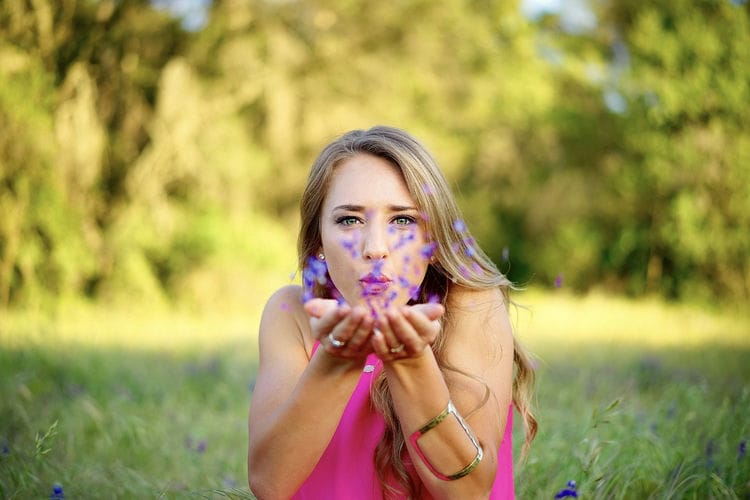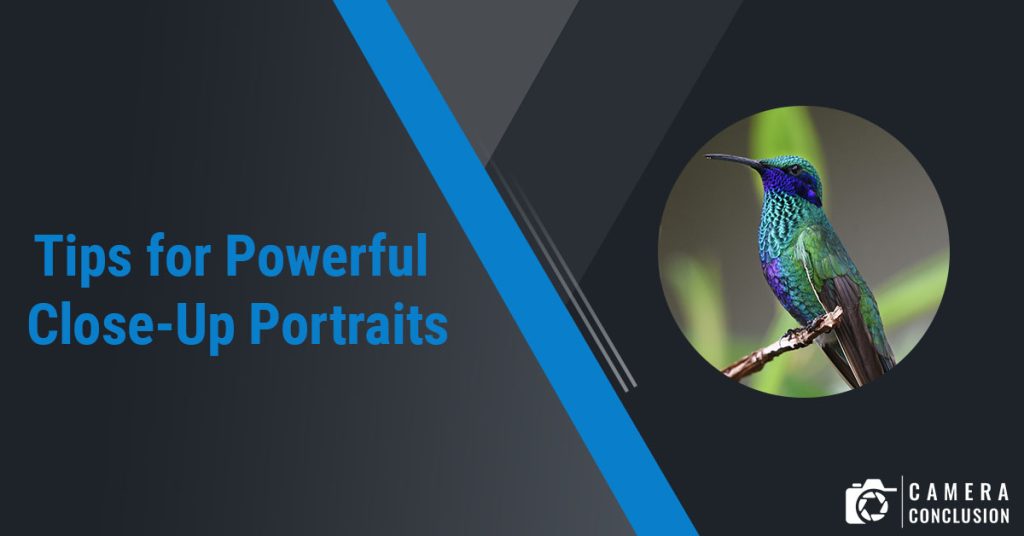Index
Close-up portraits, also known as headshots or facial portraits, are a popular and powerful way to capture a subject’s personality and emotion. Whether you’re a professional portrait photographer or just starting out, there are many techniques and tips you can use to create compelling close-up portraits.
In this guide, we’ll cover the key elements of creating powerful close-up portraits, including choosing the right lens, setting focus, lighting, aperture, composition, capturing emotion and expression, and post-processing.
By the end of this guide, you’ll have a solid understanding of the techniques and tools necessary to capture stunning close-up portraits.

Choose the right lens
Choosing the right lens is an essential element of capturing powerful close-up portraits. Here are some tips for selecting the best lens for your close-up portraits:
- Choose a portrait lens: A portrait lens is generally a prime lens with a focal length between 50mm and 100mm. These lenses provide a flattering perspective and have a wide aperture that allows for a shallow depth of field, creating a beautiful bokeh effect.
- Consider the focal length: The focal length of the lens will affect the distortion of the image. Shorter focal lengths (below 50mm) can create a wide-angle distortion that can be unflattering for close-up portraits, while longer focal lengths (above 100mm) can flatten the subject’s features. The ideal focal length for close-up portraits is generally between 85mm and 105mm.
- Choose a lens with a wide aperture: A wide aperture (low f-number) allows for a shallow depth of field, which can create a beautiful bokeh effect and blur the background, drawing the viewer’s attention to the subject’s face. Lenses with apertures of f/1.4, f/1.8, or f/2.8 are ideal for close-up portraits.
- Consider the lens type: Prime lenses are generally preferred for close-up portraits because they offer a wider aperture and sharper image quality. However, if you prefer the versatility of a zoom lens, choose one with a wide aperture and a focal length range that suits your needs.
By choosing the right lens, you can create beautiful and powerful close-up portraits that capture the essence of your subject’s personality and emotion.
Set the focus
Setting the focus is crucial for capturing sharp and powerful close-up portraits. Here are some tips for setting the focus:
- Use manual focus: Manual focus gives you full control over where the focus is placed in the frame. It allows you to choose the exact point you want to be in focus, such as the subject’s eyes, which are often the focal point of close-up portraits.
- Use autofocus: If you prefer to use autofocus, make sure you select the appropriate focus mode for your camera. Single-point AF is the best choice for close-up portraits as it allows you to choose the focus point. Continuous AF mode is not recommended as it may result in focusing on the wrong part of the subject.
- Use back-button focus: Back-button focus separates the focusing function from the shutter button, allowing you to lock the focus on your subject and recompose the shot without losing the focus point. This technique is particularly useful for close-up portraits, where the subject’s position may change slightly during the shoot.
- Check the focus point: After taking a shot, zoom in on the image to check that the focus is sharp on the intended area, such as the eyes. If the focus is slightly off, adjust the focus point and take another shot.
By using these techniques, you can ensure that your close-up portraits are sharp and in focus, capturing the subject’s personality and emotion with clarity and precision.

Consider lighting
- Use soft light: Soft light is generally the most flattering for close-up portraits, as it creates a gentle and even illumination that minimizes harsh shadows and highlights. You can achieve soft light by using a large light source, such as a softbox or umbrella, or by bouncing the light off a reflector or white wall.
- Avoid harsh light: Harsh light, such as direct sunlight or strong overhead lighting, can create harsh shadows and unflattering highlights, which can be especially noticeable in close-up portraits. If you must use harsh light, try to diffuse it with a diffuser or scrim to soften the shadows.
- Consider the color temperature: The color temperature of the light can affect the mood and tone of the portrait. Warm light, such as that from a candle or tungsten bulb, can create a cozy and intimate mood, while cool light, such as that from a fluorescent or LED light, can create a more clinical or modern look.
- Experiment with angles: The angle of the light can also affect the mood and tone of the portrait. A front-on light can create a bright and friendly mood, while a side light can create a more dramatic and moody look. Experiment with different angles and see how they affect the portrait.
Choose the right aperture
- Choose a wide aperture: A wide aperture (low f-number) allows for a shallow depth of field, which can create a beautiful bokeh effect and blur the background, drawing the viewer’s attention to the subject’s face. Lenses with apertures of f/1.4, f/1.8, or f/2.8 are ideal for close-up portraits.
- Consider the distance between the subject and the background: The distance between the subject and the background will affect the blur created by a wide aperture. If the subject is close to the background, a wide aperture will create more blur, while if the subject is far from the background, the blur will be less pronounced.
- Focus on the eyes: In close-up portraits, the eyes are often the most important part of the image, and should be in sharp focus. To achieve this, choose a wide aperture and focus on the eyes using manual focus or back-button focus.
- Use depth of field to your advantage: Depth of field can be used creatively to create a sense of depth or to draw attention to a specific part of the image. For example, you could use a wider depth of field to include more of the subject’s face or a narrower depth of field to isolate a specific feature.
Pay attention to composition
- Consider the rule of thirds: The rule of thirds is a basic principle of composition that can be applied to close-up portraits as well. Imagine dividing the frame into thirds both vertically and horizontally, and placing the subject’s eyes at one of the intersections of those lines. This can create a more visually pleasing and balanced composition.
- Use negative space: Negative space is the area around the subject that is left empty. Using negative space can create a sense of balance and help draw the viewer’s attention to the subject’s face. Try experimenting with different amounts of negative space to create different moods and effects.
- Pay attention to the background: The background can play an important role in close-up portraits. A cluttered or distracting background can take away from the impact of the subject’s face. Look for a clean and simple background that complements the subject and enhances the mood of the portrait.
- Experiment with angles: Changing the angle at which you shoot can create different moods and effects in close-up portraits. Try shooting from above, below, or at eye level to create a unique perspective.
Capture emotion and expression
Capturing emotion and expression is perhaps the most important aspect of creating powerful close-up portraits. Here are some tips to help you capture the emotions and expressions of your subject:
- Interact with your subject: Building a rapport with your subject can help them feel more comfortable and natural in front of the camera, which can lead to more authentic and emotive expressions. Talk to your subject, ask them questions, and make them feel at ease.
- Encourage natural expressions: Rather than asking your subject to smile or pose in a certain way, encourage them to be themselves and capture their natural expressions. You can do this by asking them to think about something that makes them happy or by engaging them in conversation.
- Pay attention to the eyes: The eyes are often the most expressive part of the face, and can convey a range of emotions. Make sure they are in sharp focus and try to capture a catch light or reflection in them, which can bring them to life.
- Use movement: Movement can add a sense of energy and dynamism to close-up portraits, and can be used to capture the subject’s emotions in a more dynamic way. Ask your subject to move their head or shoulders, or try moving the camera slightly to create a sense of movement.
Post-processing
Post-processing is an essential part of creating powerful close-up portraits. Here are some tips to help you enhance your images in post-processing:
- Adjust exposure and white balance: Exposure and white balance are essential elements of any image, and can be adjusted in post-processing to create a more accurate and visually appealing image. Use the histogram and white balance tools in your editing software to make adjustments as needed.
- Enhance contrast and clarity: Increasing contrast and clarity can help bring out the details and textures in your close-up portraits, creating a more dynamic and impactful image. Use the contrast and clarity sliders in your editing software to make these adjustments.
- Retouch skin and blemishes: Close-up portraits can often reveal blemishes and imperfections in the skin. Use the healing brush or clone stamp tool in your editing software to retouch skin and remove any distracting blemishes.
- Add creative effects: Post-processing can also be used to add creative effects to your close-up portraits, such as adding a vignette or applying a filter. Experiment with different effects to see what works best for your image.
- Be subtle: It’s important to remember that less is often more when it comes to post-processing close-up portraits. Avoid over-processing your images, which can make them look artificial and detract from the natural beauty of your subject.
By using post-processing techniques to enhance your close-up portraits, you can create powerful and impactful images that capture the essence of your subject’s personality and emotion.
Conclusion
Creating powerful close-up portraits requires a combination of technical and creative skills. By choosing the right lens, setting the focus, considering lighting, choosing the right aperture, paying attention to composition, capturing emotion and expression, and using post-processing techniques, you can create stunning and impactful portraits that connect with your viewers on an emotional level.
Whether you’re a professional photographer or an amateur, these tips can help you take your close-up portraits to the next level and create images that are both technically sound and emotionally engaging.
